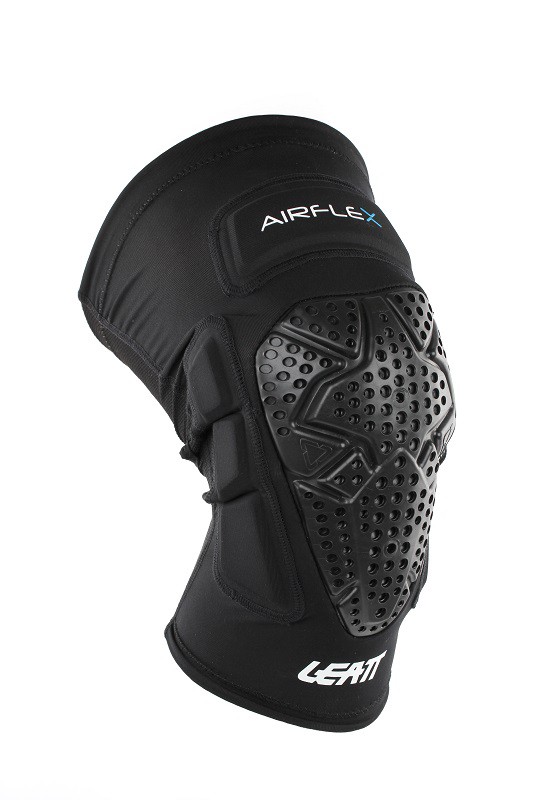
Leatt AirFlex Pro Knee Pads
Size Tested: Medium
Stated Features:
- CE tested and certified as impact protection: Knee EN1621-2
- Total Leatt protection score of 15 points
- 6mm CE impact certified profile
- New side & upper knee impact protection
- New silicon printed cupped knee grip
- New single sizing for perfect fit
- New MoistureCool & AirMesh fabrics
- Wicking, vented & antimicrobial
- All protection materials perforated for ventilation
- Silicone printed non slip cuffs
- Pre-curved 3D design for better fit & function
Stated weight per pair: 300 g
MSRP: $79.99
Intended Use: Lightweight protection with maximum ventilation
Test Location: Whitefish, MT
Test Duration: About 10 rides
Reviewer: 5’9” 155 lbs
Intro
Leatt has been making the “light duty” Airflex series of pads for a little while now, but they’ve recently added the new Airflex Pro, which add a bit of extra padding to the sides and top. This means the Airflex Pro lands somewhere in the middle of Leatt’s lineup, with the burlier Enduro and Hybrid lines offering more protection, and the original 3DF Airflex offering a little less padding.
Construction
Like a number of other similar pads, the Airflex Pro is essentially a knee warmer with some padding on it. This means they’re quite light, and they’re designed with pedaling in mind.
The primary protection is composed of Armourgel, which is a “visco-elastic polymer,” a material that hardens on impact. The idea is similar to a few other soft-shell pads on the market; the pad stays flexible and comfortable to pedal in, but when things go awry and you hit the dirt, the Armourgel stiffens up and provides some protection.
The main Armourgel pad over the knee cap is nicely contoured, and there’s also a bit of silicone grippy material on the inside. All of this helps keep the primary pad stay situated.

The Airflex Pro (unlike the original Airflex) also has additional padding along the sides of the knee as well as above the knee cap. These pads aren’t Armourgel—they’re an unspecified, much softer foam. They’re not going to protect against a hard impact, but they will help to ward off glancing blows and smacking the side of the knee against the frame.
To me, the primary distinguishing feature of the Airflex Pro, as compared to other pads on the market, is that Leatt went out of their way to make it as breathable as possible. The main Armourgel pad is perforated to allow air to pass through it. The fabric is called, “MoistureCool,” it has a very open weave, and there’s a substantial cutout behind the knee. All of this adds up to make for the most ventilated knee pad I’ve worn, and that makes a noticeable difference on the trail.
Protection and Certification
Leatt is somewhat unique in the bike protection world in that they get almost all of their pads CE certified. The certification does not, in and of itself, mean that the pads protect better than some other non-certified pad, but it does mean that you have a better idea of what exactly you’re getting with the Leatt pad.
The AirFlex Pro passes the EN1621-2 test, which was originally designed for motorcycle gear, but since mountain bike specific tests don’t exist in this context, it’s the most relevant option. The test involves dropping a 5 kg mass onto the pad with 50 J of kinetic energy, and to pass, the pad has to transmit, on average, less than 18 kN of force.
Correction: An earlier version of this review included a statement that 4mm of Armourgel could stop a .22 bullet, which we tested and found to be untrue. It was called to our attention that 4mm of Armourgel should stop a .22 pellet, but not a .22 bullet. A .22 bullet, which we tested, will generally have a slightly higher velocity than a .22 pellet, and the .22 bullet weighs about 4x as much as the pellet. Below is a video from Armourgel showing the material stopping such a pellet. We’ve also kept the video with our test of a .22 bullet, but since the pads aren’t intended to withstand that sort of force, the outcome is not at all surprising.
Purely based off of my impressions from fiddling with the pad, I’d say the Armourgel on the AirFlex Pro is better equipped to ward of pointy obstacles than, for example, the G-Form Pro-X knee pads. The padding on the AirFlex Pro is stiffer, and seems more likely to survive an attempted puncture, as long as the puncture doesn’t come in the form of a speeding bullet (or, I suppose, Superman).
NEXT: Fit, The Ride, Etc.
